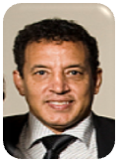Monday, April 19, 2010ن• 09:00 ~ 12:30
Location: Room 801
Tutorial 1:نNetwork Virtualization Research Challenges
Instructor:نOmar Cherkaoui, UQAM, Montreal, QC, Canada |
 Abstract Abstract
Network Virtualization is one of the main concept on which the next generation network will be based. Many research groups in the US, Europe and elsewhere in the world are investing on different aspects of virtualized Network; and many providers and vendors are very interested in exploring how this concept and associated technologies would help solve their business problems and create new growth opportunities. This tutorial will provides an introduction to the main research challenges of network virtualization (NV) be answering to following questions: how to discover and advertise the network resources; how to create and manage an slice or node across diverse resources; how does virtualization extend the Wireless and Optical links; how to implement virtualization across diverse resources and across layers of protocol stack; how to manage slice; what kind of service the network infrastructure providers will offer to the network providers, what kind of capabilities are enabled by infrastructure virtualization. Behind those research challenges, there is a need to implement this virtualized node in order to validate and experiment this new infrastructure. This implementation will require revisiting some very important Hardware and OS concepts such as VMM, Hypervisor, FPGA, Network Processor, Models of resource isolation, resource scheduler, etc. We will introduce during this tutorial those concepts, which will be need for sharing of firmware resources between the different slice processing, memory, IO and bandwidth sharing. And finally, we will review the main architectures proposed by the different projects.
Biography:
Omar Cherkaoui received his M.Sc. (1981) and Ph.D. (1988) from the Univ. of Montreal (Canada). He is a Professor of Computer Science at Univ. of Quebec in Montreal (Canada). He has (co)authored more than 50 peer-reviewed technical publications, multiple invited, keynote, and tutorial presentations, technical reports, and two patent disclosures. He worked during four years as a researcher at Cisco where he developed configuration and automatic test case generation solutions for the GSR. He created the research laboratory in computer networks (Lab Tठlठinformatique) where he supervised multiple projects in the domain of hi-speed network management, Web services platform and new multimedia software (UCLP, Validmaker, Articiel, BIOGRID,) His research interests include network management (standardization, protocols, configuration, validation, modelling, testing), optical networks, etc. Omar is a member of the technical program committees of a dozen network management conferences.
Monday, April 19, 2010ن• 09:00 ~ 12:30
Location: Room 802
Tutorialن2: Between Active and Passive Approaches to Network Performance Analysis
Instructor: Marat Zhanikeev,نAssistant Professor, Waseda University, Tokyo, Japan |
 Abstract Abstract
The main goal of the tutorial is to draw connections between active and passive approaches to network performance measurement and analysis. Active approach is also referred to as probing and is based on sending packets into the network and inferring its end-to-end performance at the other end of the path. Passive analysis is almost equally shared between the worlds of SNMP and NetFlow. When the term “network performance” is used together with verbs “measure”, “analyze”, or even “manage”, it is impossible to tell whether active or passive (according to definitions above) method is to be undertaken. In recent years, the scope and use of active measurement is increasing while passive methods continue to improve on efficiency. Yet, to the day, a paper or a talk on the topic has to clarify whether the measurement is active or passive, and, thus, kind of “pick a side”. In reality, as well as in some recent research works in the area, the two can be used together, augmenting each other’s capabilities. With network activities becoming truly global through distribution and dynamic topology, it is hard for a network activity to be contained within a single AS. End-to-end paths today average between 6 and 11 hops in length and can span from 4 to 6 ISPs from one end to the other.
Clearly, passive network performance analysis is not very helpful simply because users at path ends or event individual ISPs along the path do not have administrative access to routing equipment on the whole path.هOn NGN side, although NGN networks have already been commissioned in many countries, the area of network performance is still not complete in NGN standards. The two areas on the topic are dubbed “Network Performance Measurement” and “Network
Performance Measurement Management” in NGN and is reflected in several documents, most of which are still in draft stages. The delay in understandable, - network performance measurement on long end-to-end paths requires continuous inter-AS cooperation. This is clearly too sudden a change for providers.
Biography:
Marat Zhanikeev received M.S. and Ph.D. in global information and telecommunications studies from Waseda University in Tokyo, Japan, in 2003 and 2007, respectively. He has co-authored close to a 100 peer-reviewed papers, as well as several invited papers and tutorials. His current research interests include network measurement, network monitoring, and network management, and can roughly be embraced by the area of network performance in general. End-to-end network performance is specifically his immediate target at the time of this writing. He is presently an assistant professor at School of International Liberal Studies, Waseda University, and is a Regular Member of IEICE.
Monday, April 19, 2010ف• 14:00 ~ 17:30
Location: Room 801
Tutorial 3: Grid and Cloud Computing Management and Security
Instructor: Carlos Westphall,نProfessor, Federal University of Santa Catarina, Florianpolis – SC – Brazil |
 Abstract Abstract
Grid computing technologies are being applied as an affordable method to clusterفcomputational power together. These structures aim to support service applications by grouping devices and shared resources in one large computational unit. However, the management complexity grows proportionally to the number of resources being integrated. From a given point up, manual management of large grid structures is unfeasible. This scenario calls for automated management methods to support availability, quality of service and optimized configurations. This tutorial presents the design of a grid computing management system based on autonomic elements, which aims to promote characteristics of self-management.
Providing security in a distributed system requires more than user authentication with passwords or digital certificates and confidentiality in data transmission. Rigorous control of the executed tasks is needed in order to prevent malicious users from breaking policies, to identify the use of stolen passwords, and also to make possible rapid detection of known attacks. In this tutorial, a solution for intrusion detection in grid and cloud computing environment is presented in which audit data is collected from the cloud and two intrusion detection techniques are applied. Analysis for anomaly detection is performed to verify if user actions correspond to known behavior profiles and knowledge analysis is performed to verify security policy violations and known attack patterns. This approach was evaluated in terms of performance results.
There is no consensus about what exactly cloud computing is, but some characteristics are clearly repeated. It is a new distributed computing and business paradigm. It provides computing power, software and storage and even a distributed data center infrastructure on demand. To make these characteristics viable, it makes use of existing technologies, such as virtualization, distributed computing, grid computing, utility computing and Internet. In this tutorial, we investigate what are the security problems involving this new paradigm, trying to obtain what are the main security problems cited in the available literature and, when possible, trying to point some directions in how to solve them.
Biography:
Carlos Becker Westphallفis Full Professor (since 1993) in the Department of Informatics and Statistics at the Federal University of Santa Catarina - Brazil, where he acts as the leader of the Network and Management Laboratory and also coordinates some projects funded by the Brazilian National Research Council (CNPq). Obtained a degree in Electrical Engineering in 1985 and a M.Sc. degree in Computer Science in 1988, both at the Federal University of Rio Grande do Sul, Brazil. Obtained a D.Sc. degree in Computer Science (Network Management) at the Universitछ Paul Sabatier, France, in 1991. He acted as a local group coordinator in the European MAX/ESPRIT II project which involved the Alcatel- TITN, British Telecom, HP, CSELT, SIRTI and NKT Companies.
Technical Program and/or Organizing Committee member (since 1994) of IFIP/IEEE IM (International Symposium on Integrated Network Management), IEEE/IFIP NOMS (Network Operations and Management Symposium), IEEE/IFIP DSOM (Distributed Systems Operations and Management), IEEE LANOMS (Latin American NOMS), and IEEE APNOMS (Asia Pacific NOMS). He was the founder of LANOMS. Board of Editors (since 1995) and Senior Technical Editor (since 2003) of the Journal of Network and Systems Management of Springer. Editorial Board member (since 2004) of the Computer Networks Journal of Elsevier. Associate Editor (since 2006) of the Journal of Communication and Information Systems of IEEE ComSoc/SBrT.
Since 2003 member of the core team of the TMF UP (TeleManagement Forum Universities Program). Since 2008 Latin America - International Academy, Research, and Industry Association – IARIA Liaison Board Chair. Member 2004-2005 and 2006-2007 of IEEE ComSoc Membership Programs Development Board. From May 2000 to May 2005, he acted as "Secretary" of IEEE CNOM (Committee on Network Operation and Management). From May 2005 to May 2009, he acted as “Vice-Chair” of IEEE CNOM.
Monday, April 19, 2010ف• 14:00 ~ 17:30
Location: Room 801
Tutorial 4: Management of Next Generation and Future Networks
Instructor: John Strassner,نProfessor, POSTECH, Korea |
 Abstract Abstract
The current Internet is a critical infrastructure thatنhasنtransformed society. However, its original architecture was not designed to meet many of today’s demands; next generation networks (NGNs) and requirements of the future Internet(s) exacerbate this problem. In particular,هthe Internet faces manyهdiverseهchallenges,هincluding economic and societal requirements, which have a profound effect on the architecture of the Internet. While several significant “future Internet” initiatives have been initiated across the world, management issues tend to be ignored. Management has been viewed as something that cannot command high revenues, and hence investment and innovation has been stymied. This has now caused problems in deploying new services, such as cognitive radio, which requires additional investment in developing new regulations to govern these services. In addition, different contexts usually have different needs and interests, and different stakeholders have not been able to agree in how to fix the problems that have arisen. In order to address the technical, business, societal, and other issues that have arisen, aفholisticفsolution is necessary. This tutorial will first examine the original design focus of the Internet, and then show how some of the fundamental architectural assumptions of this original design have given rise to current and future problems in NGNs and the future Internet. Next, the business, technical, and societal requirements for NGNs and the future Internet will be examined. The tutorial will then focus on existing management proposals and the role that different standards play. The heart of the tutorial will then describe a new approach for managing NGNs and the Future Internet, and finish with conclusions and references. Each of these sections will use several examples, along with current research results, to enable the tutorial participant to see how theory is applied in academic and industrial settings.
Biography:
John Strassnerفis a Professor of Computer Science and Engineering at the Pohang Univ. of Science and Technology (POSTECH), and leads the Autonomic Computing group in POSTECH’s World Class Univ. IT Convergence Engineering division. Previously, he was a Visiting Professor at Waterford Institute of Technology in Ireland, where he worked on various FP7 and Irish research programs. Before that, he was a Motorola Fellow and Vice President of Autonomic Research at Motorola Labs, where he is responsible for directing Motorola's efforts in autonomic computing and networking, policy management, and knowledge engineering. Previously, John was the Chief Strategy Officer for Intelliden and a former Cisco Fellow. John is the Chairman of the Autonomic Communications Forum, and the past chair of the TMF's NGOSS SID, metamodel and policy working groups, along with the past chair of several IETF and WWRF groups. He has authored two books (Directory Enabled Networks and Policy Based Network Management), written chapters for 5 other books, and has been co-editor of 5 journals dedicated to network and service management and autonomics. John is the recipient of the Daniel A. Stokesbury memorial award for excellence in network management, is a member of the Industry Advisory Board for both Univ. of California Davis and DePaul Univ., a TMF Fellow, and has authored over 225 refereed journal papers and publications.
Friday, April 23, 2010 • 09:00ن~ 12:30
Location: Room 801
Tutorial 5: Autonomic Systems – Theory and Practice
Instructor: John Strassner,فProfessor, POSTECH, Korea |
 Abstract Abstract
The business, technical, and even societal aspects of systems have increased dramatically in complexity, requiring new technologies, paradigms and functionality to be introduced to cope with these challenges. This increase in complexity has made it almost impossible for a human to manage the different operational scenarios that are possible in today’s communication systems. Autonomic systems were designed to manage complexity. This tutorial provides an in-depth review of autonomic networking, and features the use of several demonstrations to illustrate the technical details taught in the tutorial. The automation of network management operations, such as configuration, will be emphasized. This tutorial uses a novel autonomic architecture, called FOCALE, to illustrate the complexities in managing wired and wireless networks, and provides the tutorial participant with a relatively deep understanding of the source of these problems and a variety of tools that can be used to solve these problems. The tools examined by this tutorial include: (1) the use of information modeling (in particular, DEN-ng) to harmonize and translate between the different languages and management methods used by different devices; (2) the use of ontologies (in particular, DENON-ng) to augment the facts defined by models with formal definitions that enable machine-based learning and reasoning to be used; (3) enhancements and alternatives to the standard “model-analyze-plan-execute” control loop used to orchestrate behavior; (4) the use of a novel context-aware policy management approach to enable the services and resources of a network to change in order to meet the demands of changes in current environments, user needs and environmental conditions; (5) how to represent different semantics associated with network configuration and service demands. The theoretical lessons in this tutorial will be reinforced with use cases and practical examples. This tutorial is important, because the potential of autonomics applied to networking has not yet been fully realized. While automation of tasks is important, autonomics can be used for many additional purposes, including integrating semantics, ensuring compliance with regulatory and other types of policy rules, and orchestrating behavior.
Biography:
John Strassnerفis a Professor of Computer Science and Engineering at the Pohang Univ. of Science and Technology (POSTECH), and leads the Autonomic Computing group in POSTECH’s World Class Univ. IT Convergence Engineering division. Previously, he was a Visiting Professor at Waterford Institute of Technology in Ireland, where he worked on various FP7 and Irish research programs. Before that, he was a Motorola Fellow and Vice President of Autonomic Research at Motorola Labs, where he is responsible for directing Motorola's efforts in autonomic computing and networking, policy management, and knowledge engineering. Previously, John was the Chief Strategy Officer for Intelliden and a former Cisco Fellow. John is the Chairman of the Autonomic Communications Forum, and the past chair of the TMF's NGOSS SID, metamodel and policy working groups, along with the past chair of several IETF and WWRF groups. He has authored two books (Directory Enabled Networks and Policy Based Network Management), written chapters for 5 other books, and has been co-editor of 5 journals dedicated to network and service management and autonomics. John is the recipient of the Daniel A. Stokesbury memorial award for excellence in network management, is a member of the Industry Advisory Board for both Univ. of California Davis and DePaul Univ., a TMF Fellow, and has authored over 225 refereed journal papers and publications.
Friday, April 23, 2010 • 09:00ن~ 12:30
Location: Room 802
Tutorial 6:نPerformance evaluation of mobile systems and services: measurements-based methodologyن
نننننننننننننننن andنexample assessment techniques
Instructor: KatarzynaنWac,نPost-Doc,نCarnegie Mellon University,نPittsburgh, USA |
 Abstract Abstract
This tutorial presents a generic methodology for measurements-based performance evaluation of a mobile computing and/or communication system and its service(s). The performance evaluation aims at analysis of, for example, system’s bottleneck or scalability characteristics or at analysis of responsiveness of its selected mobile service. The presented methodology has been derived from previous studies on performance of communication networks.The methodology is outlined with aim to perform (practical) measurements, as opposite to (theoretical and widely used) simulations or modeling, as the latter not necessary disclose the nuances of the system performance as experienced by the system user in his natural environment. The importance of the proposed methodology and the necessity of its usage are emphasized, with the aim of understanding of the user’s experiences and eventual reconfiguration or even redesign of the system. The methodology includes detailed steps for objectives determination, system instrumentation, measurement execution and performance evaluation activities. The participants will learn in-depth these methodological steps from theoretical and practical point of view, as the tutorial illustrates use of the methodology for performance evaluation of MobiHealth system and its vital sign tele-monitoring service provided to a mobile patient.
Biography:
KatarzynaهWacهis a post-doc at Carnegie Mellon Univ. working in area of Quality of Service-aware mobile systems and services. She is also a research staff member at Univ. of Twente (the Netherlands), where she is affiliated with the MobiHealth BV start-up company. In 2003 she has received a BSc and MSc degree in Computer Science from Wroclaw Univ. of Technology (Poland), and in 2004 she has completed her MSc in Telematics at Univ. of Twente. In June 2009 she defended her PhD titled “Collaborative sharing of Quality of Service-information for mobile service users” from Univ. of Geneva (Switzerland). Ms. Wac current research interests include mobile services with special emphasis on supporting adaptive multimedia protocols and Quality of Service mechanisms, especially in a mobile healthcare domain. Ms. Wac strives towards effective and efficient pervasive mobile computing and communication - meeting the end-user Quality of Service requirements and his Quality of Experience expectations. Ms. Wac has a long-standing experience in teaching (2004-2009) at Univ. of Geneva (Switzerland); MSc-level courses given are: “Mobile Systems and Services” and “Multimedia Communications”. She has been also invited to give occasional talks (years: 2006-2009) on mobile healthcare systems and services to MSc students participating in the course “Mobile Services” at Blekinge Institute of Technology (Sweden).
Friday, April 23, 2010ف• 14:00ن~ 17:30
Location: Room 801
Tutorial 7:نSmart Services for Elderly in the Home: Autonomic U-Care and U-Health
Instructor: Nazim Agoulmine,نProfessor, University d’Evry, Evry, France |
 Abstract Abstract
All developed countries are facing tremendous social challenges in the near future. Among these challenges, the increase of aging population is a major problem for all healthcare systems that have been hardly built during many decades. This increase of elderly is leading to an increase of the number of people with impairments, disabilities or chronic deceases that make them dependent. This situation is unsustainable for many families and countries and will certainly lead to the collapse of their healthcare system if any actions are not taken very quickly. Fortunately, we have seen recently an important advance in new technologies that could be used to provide innovative solution in this area. This market is very promising for ICT (Information and Communication Technologies) as these technologies could be used to address a number of situations by anticipating injuries, serious health accidents and facilitate the care and independence of elderly helping them to leave safely and independently in their home.This tutorial will firstly present the challenges of healthcare systems in future society. It will then presents a state of art of existing initiatives providing solutions to reduce healthcare cost by improving the remote monitoring of patients and elderly. Next, the presentation will focus on the technologies that will facilitate the improvement of these solutions (bio and nano technologies, networking technologies, autonomic technology). The next part of the presentation will address the challenges posed by the system in term of decision-making distribution and pro-active control and the need for a more autonomic approach. The presentation will then focus on a particular case study that is heart anomaly monitoring and detection and will show how a service around this particular disease can be deployed. The perception of such as system from people is very important and thus the tutorial will address the problem of Quality of Health. Finally, the presentation will present a real system that is under development at POSTECH (Korea) in the frame of the WCU project.
Biography:
Nazim Agoulmineهis a professor at the Univ. of Evry Val d’Essonne and a WCU Distinguished Visiting Professor at POSTECH. His research topics are Autonomic Systems and their applications to the management of Smart Spaces. He is also working on Policy based management, network management, Quality of Service in broadband wire and wireless networks, sensor networks, Seamless Mobility in 4G, Context Awareness, Semantic Web, etc. Dr Nazim Agoulmine holds a Ph.D. degree in Computer Science from the Univ. of Paris 11 – Orsay, France. Since 1989, he has been involved in several national and international research projects on broadband wireless and fixed network management funded by the European commission (Advance, Pemmon, Forms, ICM, Adanets, Seimonet, Sumo, Wellcom, Expeshare, Magneto) and the French government (Cesame, Amarrage, Polymage). He has co-authored three books on network architectures and management. He is a member of the editorial board of the International Computer Communication Journal and co-editor of the Wireless Letter (Technique de l’Ingडnieur Publisher in France). He is a member of several technical programme committees of IEEE international conferences, MMNS, IM, NOMS, GLOBECOM, APNOMS, LANOMS, MWCN, LAACS, GIIS, MUCS, etc.
|